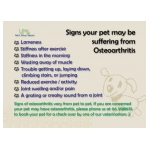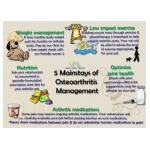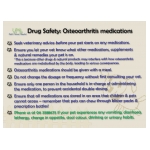

Osteoarthritis
What is the Difference between Arthritis and Osteoarthritis?
Broadly, arthritis refers to inflammation of a joint/s. It may be caused by trauma, infection, an over-active immune system, degenerative or developmental problems. Osteoarthritis, also known as degenerative joint disease is thought to occur as a result of abnormal forces during weight-bearing and movement. Abnormal forces acting over a joint during weight-bearing/movement may arise in conditions whereby the joint is not stable due to an underlying disease process (e.g. un-treated fracture near a joint, joint dislocations, torn knee ligaments etc); or if the joint has not developed properly (e.g. hip or elbow dysplasia).As a consequence, excessive load is placed on the joint cartilage, causing it to “wear out” quicker and become thinned. The worn out cartilage is unable to “cushion” the joint during weight bearing causing low-grade trauma to the joint which, induces inflammation within the joint. This inflammation causes excessive amounts of joint fluid accumulation with subsequent formation of bony growths within the affected joint. Osteoarthritis is therefore the collective train of changes that occurs secondary to abnormal joint biomechanics.Over time, osteoarthritis can lead to reduced joint mobility as well as pain. It is often seen in older dogs and in some cats. On average, osteoarthritis affects an estimated one in every five dogs. Click on each of the below images to find out more.
Signs Your Pet May be Suffering from Osteoarthritis
Some of the clinical signs seen with osteoarthritis includes, but are not limited to:
- Lameness
- Stiffness after exercise
- Stiffness in the morning and then gets better as the pet “warms up”
- Wasting away of muscle
- Trouble getting up, laying down, climbing stairs, or jumping
- Unable to walk/run as far as he/she normally does
- Joint swelling and/or pain
- A grating sound in a joint
Remember that every pet is different and may not display any of the clinical signs listed above. Recognising osteoarthritis in pets can be difficult because the condition progresses slowly. Also, some owners assume that signs of osteoarthritis are “normal” in older animals where in fact, the pet is in discomfort because of joint pain secondary to the osteoarthritis.
How is Osteoarthritis Diagnosed?
Radiography (x-rays) can reveal bony growths and joint abnormalities. Depending on the extent of lameness and physical examination findings, your veterinarian may also recommend other diagnostics such as blood tests or obtaining a sample of the joint fluid for testing, in order to rule out other disease processes (e.g. infected joint).
How Osteoarthritis may be Managed
Strictly speaking, there is no “cure” for osteoarthritis. Once a pet has osteoarthritis, the condition is generally progressive. However, there are a number of treatments and management factors (listed below) that can slow the progression of osteoarthritis. While the following list may appear very long, every pet is different and thus may not require all the treatments listed below your veterinarian will tailor a treatment plan specifically for your fur friend.
1) Weight management: Keeping your pet slim can help by decreasing the load on his or her joints.
2) Exercise moderation: Carefully monitored, low-impact exercise on soft surfaces (e.g. grass verge) can help affected dogs.
3 Physical therapy: This may increase your pet's flexibility, circulation, and sense of well-being. Professional animal physical therapists are available. Consult your veterinarian for more details.
4) Disease-modifying osteoarthritis drugs (e.g. Cartrophen): While these drugs do not reverse the osteoarthritis, they act to either slow cartilage degradation and/or promote the formation of joint fluid to help better lubricate the joints.
5) Joint supplements (e.g. Glucosamine/chondroitin; green-lip mussel extract): These agents act to support and promote joint health.
6) Prescription joint diets (e.g. Hill's j/d): These diets have been specially formulated for dogs and cats affected by osteoarthritis and are high in omega-3 & -6 fatty acids.
7) Pain medication: This may help alleviate the observed clinical signs. Non-steroidal anti-inflammatory drugs are commonly prescribed by veterinarians to reduce pain and discomfort associated with osteoarthritis. Many pain relievers that help dogs and people are poisonous to cats. You should never give your pet a medication without your veterinarian's recommendation.
8) Environmental modification & general home care: Padded pet beds and slip-free flooring at home can help. It is also useful if the fur between your pet's toes are kept short such that the paw pads are well-exposed allowing him/her to have better grip during walking/running. If your pet frequently traverses the stairs at home, building a slip-free ramp may also help him/her navigate the stairway better.
9) Surgery: In very advanced cases of arthritis where the above non-surgical strategies are unable to effectively manage your pet's level of discomfort associated with the arthritis, your veterinarian may recommend “salvage” surgery e.g. total hip replacement, femoral head/neck ostectomy, arthrodesis etc. Some of these procedures may require a referral to a surgical specialist your veterinarian will be able to provide you with more details.
Prevention & Early Detection
Regular, moderate exercise and a high-quality diet can help delay damage to the joint cartilage, manage body weight, and keep your pet's musculoskeletal system in good shape. Do keep in mind that depending on the origin of the abnormal joint biomechanics (see earlier section), osteoarthritis may not be fully preventable in some pets. However, with proper management, we may be able to slow the progression of and minimise the severity of osteoarthritis in affected pets.
Ask your veterinarian to recommend an exercise programme and a diet that are appropriate for your pet. Bringing your pet in for regular health checks may also help your veterinarian identify clinical signs early.



